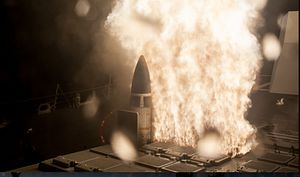Prior to the COVID-19 global pandemic, President Donald Trump made clear his intention to engage China and Russia to seek new agreements limiting theater- and intercontinental-range nuclear missiles.
However, the Chinese Communist Party (CCP) leadership’s long-standing refusal to join nuclear limitation negotiations, its People’s Liberation Army’s (PLA’s) current overwhelming superiority in theater nuclear and nuclear capable systems, and its broad investments in new intercontinental nuclear systems and new strategic missile defenses, require that Washington also place a high priority on developing new strategic nuclear capabilities and making additional investments in missile defenses to counter this aggression.
The logic for pursuing negotiations is compelling: there is a good chance that China is seeking nuclear parity, if not superiority, versus the United States. Yes of course, China regularly denies that it seeks a large strategic nuclear force. But perhaps such statements, combined with China’s abhorrence of nuclear transparency, reflect its deeper history of strategic deception.
After all, it was China’s achievement of decisive superiority in theater nuclear-capable missiles, about 1,800 to 2,000 systems, that helped the Trump administration withdraw from the 1987 Intermediate Nuclear Forces (INF) Treaty with Russia. The PLA Rocket Force (PLARF) now has the precision land-attack and anti-ship capable, 4,000-kilometer range Dong Feng (DF)-26 and the 2,000-km range DF-17, the world’s first maneuverable anti-missile evading Hypersonic Glide Vehicle (HGV) armed theater missile.
Defense Intelligence Agency Director Lt. Gen. Robert P. Ashley’s May 30, 2019 statement at the Hudson Institute that China could over the next decade “double the size of its nuclear stockpile,” which could reach about 600 nuclear warheads, is regarded as an overestimate by some analysts. But this could be an underestimate considering the variety of new intercontinental missiles now being deployed or developed.
The PLARF may have three six-missile brigades of the liquid-fueled silo-based DF-5 intercontinental ballistic missile (ICBM), with perhaps two brigades with the three-warhead DF-5B. Meanwhile the 10-warhead DF-5C is in development but could be succeeded by a silo-based version of the solid-fueled 10-warhead capable DF-41. A road-mobile version of the DF-41 may already equip multiple brigades and a rail-based version is also under development.
The PLA Navy (PLAN) meanwhile is reported to have tested its new, potentially multiple warhead capable, JL-3 submarine-launched ballistic missile (SLBM). And sometime in the mid-2020s, the Xian H-20 flying-wing strategic bomber will complete the PLA’s “strategic triad.”
At the same time as this Chinese missile buildup, America’s nuclear forces and missile defenses are in flux. Of note is the upgrade of the Ground-Based Interceptors (GBI) meant to destroy incoming offensive ICBMs launched at the United States.
The Redesigned Kill Vehicle (RKV), the presumptive successor to the current Exoatmospheric Kill Vehicle (EKV), was scuttled in 2019 due to budget cuts, fewer test opportunities, and an accelerated development. In its place the Pentagon has committed to developing the Next Generation Interceptor (NGI) to counter ICBM threats, but this will not be an active missile defense system until at least 2026, and some experts estimate it may not be operational for as many as 12 years. This leaves a strategic capability gap. The United States should therefore make immediate investments in missile capabilities to counter current Chinese threats.
Fully funding theater and strategic missile and missile defense programs offer the most effective means to deter China. The new medium and intermediate range missiles under development for the U.S. Army and Navy, air-launched hypersonic missiles, tactical nuclear cruise missiles, and the game-changing 1,000 mile-range Long Range Strategic Cannon are required to achieve theater parity with China. Having practiced strategic missile “defense” cooperation, it has to be considered that China and Russia may engage in nuclear missile “offense” cooperation, making it crucial to fund U.S. nuclear triad modernization.
It is also crucial to fund current theater and strategic missile defense programs to fill the gap while the NGI is being developed. Interceptors such as the Navy’s SM-3 and SM-6 missiles, systems such as Aegis Ships and Aegis Ashore, and an extended-range version of the Theater High Altitude Area Defense (THAAD) system are all examples of proven, cost-effective technologies that the United States can procure now to counter current threats while simultaneously investing in technological advances to meet growing long-term demand.
Such commitments will be essential to meet China’s nuclear challenge and convince Beijing to finally consider verifiable nuclear limitation agreements. Congress and the Trump administration must ensure funding for them when the time comes for post-coronavirus U.S. defense spending adjustments.
Richard D. Fisher, Jr. is a senior fellow with the International Assessment and Strategy Center.

































